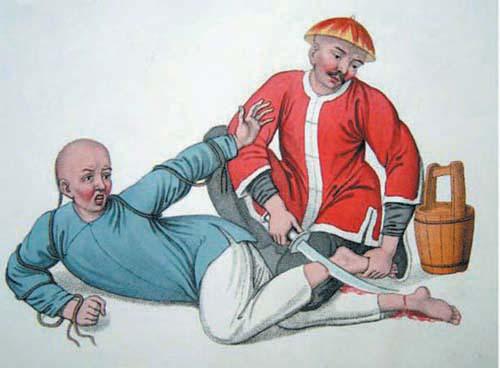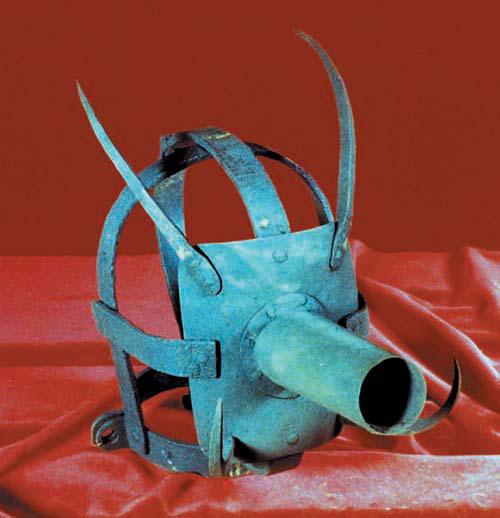Read The Big Book of Pain: Torture & Punishment Through History Online
Authors: Daniel Diehl
The Big Book of Pain: Torture & Punishment Through History (52 page)

BOOK: The Big Book of Pain: Torture & Punishment Through History
10.5Mb size Format: txt, pdf, ePub
ads
A staple, in one variation or another, of any respectable torture chamber. A deviously simple design which delivered the requisite amount of pain to any victim unlucky enough to be seated within, the chair was of a sturdy wooden construction strategically embedded with up to 2,000 metal spikes.
The victim, always naked, was strapped within the chair using tight leather straps, wooden braces, and/or metal cuffs. The initial pain of hundreds of sharp rusty spikes penetrating the flesh could always be increased by the torturer forcibly pressing the prisoner down and back against the spikes. Variations (without spikes) were used to bind the victim so that the torturer could easily baste his or her feet with lard or oil heated by nearby braziers.
Often, the ‘seat’ would be made of metal so that a fire could be lit beneath with obvious painful consequence. Note also in the image above left, the presence of the spiked plank designed to be tightened against the shins forcing the calves tight against the spikes of the frame. And of the second plank designed to rest beneath the soles of the victim’s bare feet.
A modern ‘improvement’ features systematically sending an electric current through the chair.


These images depict various military punishments inflicted on soldiers for various transgressions as a means of maintaining discipline.
In the field, summary punishments were unusually preferred to more formal legal proceedings. Facilities for imprisonment were limited, and every convicted soldier removed from active service placed an added burden on the rest of the troops in the company.
Field Punishment Number 1 consisted of the convicted man being shackled in irons and secured to a fixed object, often a gun wheel or similar. He could only be thus fixed for up to two hours in twenty-four, and not for more than three days in four, or for more than twenty-one days in his sentence. This punishment was often known as ‘crucifixion’ and due to its humiliating nature was viewed by many soldiers as unfair.
Field Punishment Number 2 was similar except the man was shackled but not fixed to anything. Both forms were carried out by the office of the Provost-Marshal, unless his unit was officially on the move when it would be carried out regimentally i.e. by his own unit.


In the left-hand image we see an illustration depicting savage tortures used by ‘primitive peoples’. This illustration is typical of the sorts of propaganda which underlined and supported the expansive policies of colonisation espoused by Europeans from the sixteenth–nineteenth centuries. Ironically, the tortures depicted as evidence of ‘savagery’ were each readily identifiable in Europe as well. We see the torture of the saw, of impalement, of burning at the stake, or burying alive, of cutting off ears or tongues and of bastinado (caning of the feet).
Below we see one of the many forms of torture and punishment which were commonplace in the Orient. In this case we see an instance of ‘hobbling’ whereby the achilles tendons of a victim are severed so he cannot walk or even stand. This sort of punishment was probably imposed on slaves who attempted to run away (though of what use a recaptured slave who is incapable of standing would be is uncertain).

This crucifix conceals a dagger. The purpose of this implement was supposedly to aid in the redemption and dispatch of a heretic who was being publicly executed by the office of the Inquisition, perhaps during an
auto-de-fe
. If the victim would recant their ‘transgressions’ and embrace the cross (in some way) the Inquisitor might be willing to have mercy on them and kill them quickly with the dagger rather than let them die slowly and painfully in the flames.

This simple yet exquisitely made implement would be used to sever parts of the victim. It could be used in a variety of ways from tongues to lips to nipples to finger joints, etc. As this is such a beautifully made example, it is likely that this item may have been originally intended for a different purpose such as the
Izmail
used by a
Mohel
in the Jewish ritual of circumcision.

Most people will be familiar with the story of the Man in the Iron Mask supposedly about the twin brother of King Louis XIV of France.
That story was inspired (at least in part) by objects such as this … known as Branks or masks of shame.

This collar, with its suspended bell, would have been worn by a number of different individuals singled out for public humiliation. Whether a penitent or a troublesome guild member, this item would have been locked around their neck and they would have been led through the streets while being whipped, assaulted or otherwise tormented by the raging populace.


BOOK: The Big Book of Pain: Torture & Punishment Through History
10.5Mb size Format: txt, pdf, ePub
ads
Other books
Blood and Salt by Barbara Sapergia
The Swans' War 1 - The One Kingdom by Sean Russell
The Map Thief by Michael Blanding
Randy and Walter: Killers by Tristan Slaughter
Dana Cartwright Mission 2: Lancer by Joyz W. Riter
The Two-Headed Man: Short Story by Barbara Gowdy
Oceánico by Greg Egan
One Spoonful of Trouble (Felicity Bell Book 1) by Nic Saint
Undone Deeds by Del Franco, Mark
Masquerade by Gayle Lynds